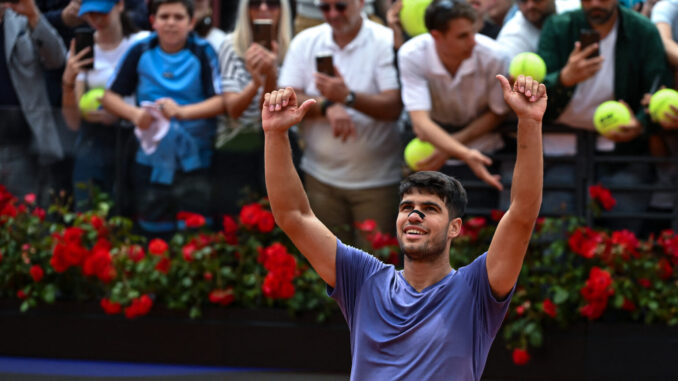
Carlos Alcaraz, the 22-year-old Spanish tennis prodigy, launched his Italian Open campaign with a commanding 6-3, 6-3 victory over Serbia’s Dusan Lajovic in the first round at the Foro Italico. The straight-sets win, marking his 25th victory of the 2025 season, was a triumphant return to competitive play after an adductor injury sidelined him at the Madrid Open. Despite the dominant performance, former British tennis player Barry Cowan highlighted two facets of Alcaraz’s game—his net play and break-point conversion—that still have room for refinement, even as the four-time Grand Slam champion continues to dazzle on clay.
The match against Lajovic, a seasoned 34-year-old qualifier, showcased Alcaraz’s resilience and adaptability. Coming off a challenging period marked by his withdrawal from Madrid and a loss in the Barcelona Open final to Holger Rune, Alcaraz admitted he was surprised by his own performance. “I think he will be happy he has played well,” Cowan noted, rating Alcaraz’s display a commendable 7.5 out of 8. Alcaraz’s serve was a standout, boasting a 71% first-serve percentage and winning 72% of first-serve points, compared to Lajovic’s 59%. His second-serve points were equally impressive at 62%, dwarfing Lajovic’s 48%. The Spaniard’s ability to dictate play from the baseline and unleash 31 receiving points underscored his dominance, but Cowan pointed out areas for growth. “There’s still room to improve on his net game and break points,” he observed, noting that Alcaraz converted only four of his 10 break-point opportunities.
Alcaraz’s journey to this point has been one of meteoric rise tempered by physical setbacks. The adductor injury, which flared during his Barcelona final, forced him to prioritize recovery over defending his Madrid title. Yet, his performance in Rome signaled a return to form. The first set saw Alcaraz break Lajovic early, capitalizing on precise groundstrokes and relentless pressure. The second set followed a similar script, with Alcaraz’s athleticism and court coverage stifling Lajovic’s attempts to rally. “I didn’t expect to play at this level after not competing for a few weeks,” Alcaraz said post-match, his trademark humility shining through. His ability to shake off rust and perform under pressure bodes well for his Rome campaign, where he aims to add to his six Masters 1000 titles.
Cowan’s critique, while constructive, highlights the high expectations surrounding Alcaraz. His net game, though effective, lacks the polish of his baseline play, with occasional hesitancy in closing points at the net. Similarly, his break-point conversion, while solid, could be more ruthless—a critical factor in tight matches against top-tier opponents. These areas, however, are mere footnotes in an otherwise stellar performance. Alcaraz’s 2025 season has been a testament to his versatility, with a Monte-Carlo Masters title and a strong clay-court resume, including back-to-back Barcelona crowns in prior years.
As Alcaraz advances to the second round, he faces a new challenge, likely against a qualifier or lower-ranked player, with the potential to climb back to world No. 2. His Rome history is checkered—last year’s third-round upset by Fabian Marozsan remains a stark reminder of the tournament’s unpredictability. Yet, with the French Open on the horizon, where he’s the reigning champion, Alcaraz’s focus is clear. “I’m just trying to enjoy playing and keep improving,” he said, embodying the mindset of a champion who’s never satisfied. For fans, his Rome opener was a thrilling glimpse of what’s to come, even as he fine-tunes the edges of his already formidable game.
Leave a Reply